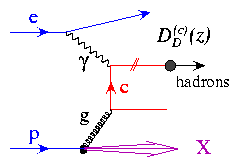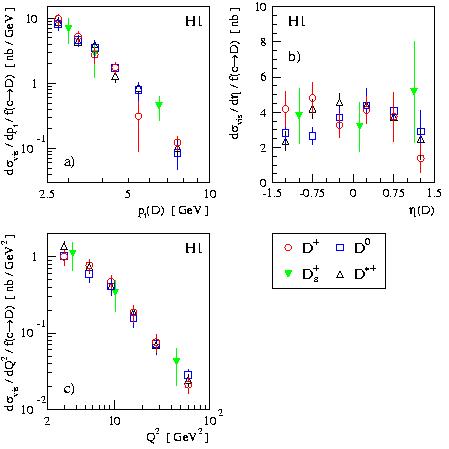 Charmed particles are produced at HERA mainly
through the photon-gluon fusion process, gamma g -> c cbar,
as shown in
the figure. A photon coupled to the incoming positron interacts
with a gluon from the proton to form a charm-anticharm quark pair.
However, because quarks are never observed ``naked'',
they have to team up with other quarks to produce bound states,
hadrons, in a process referred to as hadronisation.
The decay products of the resulting hadrons
can be observed in an experiment.
This paper is mainly concerned with the study of the hadronisation
process, specifically with the question of how likely the charmed
quarks are to hadronise to produce different hadrons.
The states under investigation are the
mesons D+, D0, D+s and
D*+, which are
bound states of charm quarks with light antiquarks.
Charmed particles are produced at HERA mainly
through the photon-gluon fusion process, gamma g -> c cbar,
as shown in
the figure. A photon coupled to the incoming positron interacts
with a gluon from the proton to form a charm-anticharm quark pair.
However, because quarks are never observed ``naked'',
they have to team up with other quarks to produce bound states,
hadrons, in a process referred to as hadronisation.
The decay products of the resulting hadrons
can be observed in an experiment.
This paper is mainly concerned with the study of the hadronisation
process, specifically with the question of how likely the charmed
quarks are to hadronise to produce different hadrons.
The states under investigation are the
mesons D+, D0, D+s and
D*+, which are
bound states of charm quarks with light antiquarks.
The commonly applied theoretical description assumes that the whole process can be factorised, i.e. broken up into several steps. The production of the c cbar pair occurs through the photon-gluon fusion hard scattering process, which is well described by calculations using perturbative quantum-chromodynamics. However, the hadronisation step cannot be calculated from first principles. Its effects are usually parameterised by some fragmentation function with parameters that are determined by experimental measurements. It is usually assumed that the fragmentation function and relative abundance of each hadron type is ``universal'' - i.e. is independent of the charm production mechanism. This implies that the same functions can be applied to e p scattering as are valid in e.g. e+ e- scattering. This paper tests the assumption that the formation of the different meson types proceeds independently of the underlying production process and the energy at which the charm quark is produced.
The measurement makes use of the fact that the charmed D-mesons have a finite lifetime and thus travel a measurable distance before decaying. This so-called decay length can be used to distinguish the interesting charmed D-mesons from other particles. It is measured in this analysis using the central silicon tracker of the H1 detector, which is located very close to the interaction point.
 The production rates of the
D+, D0, D+s and
D*+ mesons
are measured differentially as a function of different
kinematic variables.
This is shown in the figure, where the
shapes of the distributions in
the D meson transverse momentum pt(D)
and pseudorapidity eta(D), as well as the photon virtuality Q2,
are compared for all four D-mesons. Once the relative abundance factors
for the individual mesons are taken into account, the shapes of the
distributions are the same within errors, consistent with the idea
that the relevant
fragmentation functions for each type of meson are the same apart from
a normalisation factor. Furthermore, the distributions
are in agreement with a Monte Carlo simulation (not shown) which gives
predictions based on measurements from e+e- scattering,
thus incorporating the universality ansatz.
The data are thus fully consistent with universality.
The production rates of the
D+, D0, D+s and
D*+ mesons
are measured differentially as a function of different
kinematic variables.
This is shown in the figure, where the
shapes of the distributions in
the D meson transverse momentum pt(D)
and pseudorapidity eta(D), as well as the photon virtuality Q2,
are compared for all four D-mesons. Once the relative abundance factors
for the individual mesons are taken into account, the shapes of the
distributions are the same within errors, consistent with the idea
that the relevant
fragmentation functions for each type of meson are the same apart from
a normalisation factor. Furthermore, the distributions
are in agreement with a Monte Carlo simulation (not shown) which gives
predictions based on measurements from e+e- scattering,
thus incorporating the universality ansatz.
The data are thus fully consistent with universality.
Ratios of the production rates of the different D-mesons are useful to characterise distinct aspects of fragmentation processes, such as the relative probabilities for the charm quark to hadronise together with each of the light quark flavours u, d and s, or the probabilities of producing mesons in different angular momentum states. In the paper, such ratios are determined and compared with values measured in other processes. Our observations at HERA agree with those made in e+e- annihilation at LEP.
So what did we learn?
The measurements support the commonly made assumption that
the production of the charm quarks in the hard scattering
process and the fragmentation process
proceed independently of each other (factorisation).
It also appears justified to apply a universal fragmentation
description, i.e. independent of
how and at what energy the charm quarks are produced.
Charm quarks thus appear to hadronise at HERA in ep collisions in the
same manner as they do at e+e- colliders.